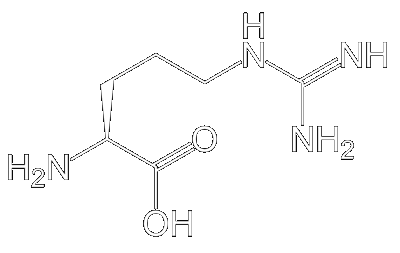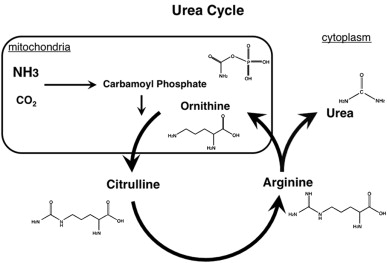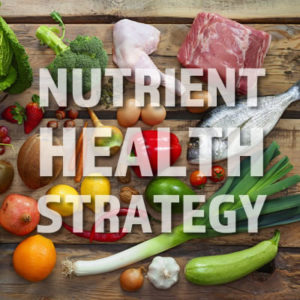Our body needs 20 different amino acids to maintain health. 11 are made by our bodies (these are called non-essential) and 9 are derived from our diet (these are called essential). You can think of amino acids as Lego bricks that come in many different shapes and sizes. When you consume protein-rich food, it is broken down to form amino acids, which are then recombined to make new material such as muscle and hormones.
- Arginine is one of the 20 plus amino acids that make up all proteins.
- Arginine is used with omega-3 fish oils and other supplements for reducing risk for infections (especially respiratory infections or problems with the lungs). It’s sometimes added to topical ointments used to treat wounds.
- Improves wound healing, shortening recovery time following cancer, illness or surgery.
- For people with high blood pressure, L-arginine supplementation reduces both systolic and diastolic blood pressure.
- Arginine may also increase the potency of PDE-5 inhibitors such as Viagra.
- Arginine is produced in our kidneys, and in the liver via the urea cycle, and is also recovered through normal turnover of body proteins.
- Arginine is recognized as safe (GRAS-status, or generally recognized as safe in foods) at intakes of up to 20 grams per day, but can have a laxative effect over this quantity.
- Studies have shown that arginine can help prevent and treat stroke, stroke-like episodes (study).
- L-arginine increases brown fat growth (good fat) and reduces white fat build up in the body. helping to lessen obesity.
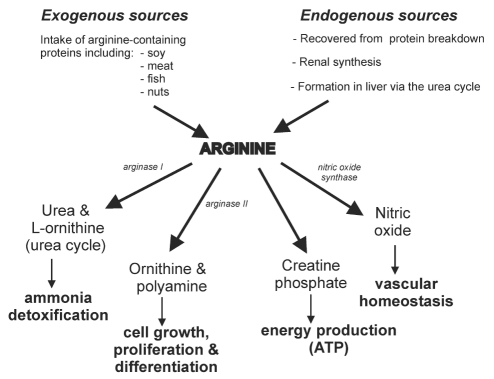
The Importance of Nitric Oxide (NO)
Nitric Oxide, a tiny molecule with the chemical formula NO, is made by the enzyme nitric oxide synthase (NOS). Studies have shown that increasing arginine increases available NO. Nitric oxide is produced by nearly every type of cell in the human body and it's very important for blood vessel health. It's a vasodilator, meaning it relaxes the inner muscles of your blood vessels, causing the vessels to widen. So nitric oxide increases blood flow and lowers blood pressure.
Nitric oxide is produced by a group of enzymes called nitric oxide synthases. These enzymes convert arginine into citrulline, producing NO in the process. Citrulline is an amino acid that was first found in watermelon, once ingested, it converts very efficiently into Arginine.
L-Citrulline is one of the three dietary amino acids in the urea cycle, alongside L-arginine and L-Ornithine. It reduces fatigue and improves endurance for both aerobic and anaerobic prolonged exercise. Your kidneys change L-citrulline into another amino acid called L-arginine and ultimately nitric oxide (NO).
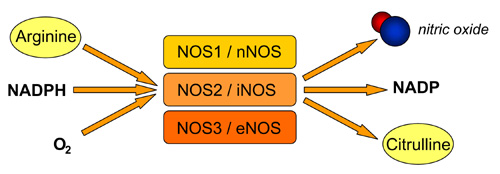
The reduced form of nicotinamide adenine dinucleotide phosphate, NADPH, is used in the production of fatty acids, cholesterol, neurotransmitters, nucleotides and amino acids. Typically enzymes involved in anabolic pathways that create large molecules use NADPH, while enzymes involved in the breakdown of molecules use the analog NADH.
Doctors often administer arginine before operations to reduce the risk of wound infections. This is called 'immunonutrition'. A combination of Arginine and citrulline is used because it has a very high conversion rate in the body. Several studies show that arginine increases the responses of T cells, increases circulating cytokine levels, enhances wound healing and collagen synthesis. Cytokines are small proteins that are crucial in controlling the growth and activity of other immune system cells and blood cells. When released, they signal the immune system to do its job, they have become very important in the studies aimed at combatting Covid-19.
Creating Nitric Oxide from Nitrate Rich Foods
In the mouth, anaerobic bacteria effectively reduce the nitrate ion to nitrite by the action of nitrate reductase enzymes. In the stomach, nitrite is spontaneously decomposed to form nitric oxide (NO) and other bioactive nitrogen oxides. Research now indicates that the nitrate-nitrite-nitric oxide pathway is involved in the regulation of blood flow, cell metabolism, and signalling, as well as in tissue protection during hypoxia. The fact that nitrate is abundant in our diet gives rise to interesting nutritional aspects of health and disease.
It's very interesting to note that modern anti-bacterial mouthwashes kill off the bacteria responsible for nitrite production - and thus their usage increases blood pressure! Nitrite synthesis by oral bacteria is hugely important in kick-starting how our bodies react to exercise over the first period of recovery, promoting lower blood pressure and greater muscle oxygenation (study).
Another study looking at the effect of chlorhexidine mouthwash on the entire oral microbiome has found its use significantly increases the abundance of lactate-producing bacteria that lower saliva pH, and may increase the risk of tooth damage.
Acute supplementation (one-off) with nitrate-rich beetroot juice causes a greater increase in plasma nitrite and a reduction in blood pressure of older compared to younger adults (study).
Nitrate Rich Foods
These foods provide the most nitrates:
- Beets (eg beetroot)
- Celery
- Lettuce
- Radishes
- Spinach
- Fennel
Smaller amounts are found in:
- Dairy products
- Beef
- Poultry and Fish
Nitrates are added to processed meats:
- Deli meat/cold cuts
- Ham & Bacon
- Sausages
- Hot dogs
Citrulline
Dietary arginine supplementation suffers from some drawbacks, including metabolism in the GI tract and in the liver (30-40%). It also has the drawback of potentially lowering blood pressure too much (although only in critically ill or very aged patients), and causing some diarrhea issues with large does. Studies have shown that citrulline supplementation may be a better alternative than arginine alone because its only fate in the body is the conversion into arginine. However, both citrulline and arginine supplementation increases plasma arginine concentration so it might be prudent to take a little of both.
Large quantities of arginine are synthesised in the kidneys from citrulline produced by the intestine. This is done via 2 renal enzymes of arginine synthesis (argininosuccinate synthetase and argininosuccinate lyase). The rate of arginine synthesis depends on citrulline delivery and does not appear to be regulated by dietary arginine availability. Renal arginine synthesis in humans produces around 2g arginine daily, which may be compared to an intake, from a Western diet, of 4-5g daily.
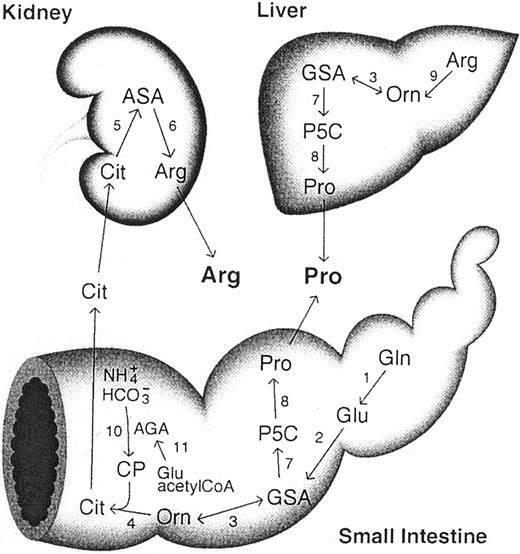
Watermelon - a Natural Viagra
Studies have found that watermelon increases the volume of semen and also has a viagra effect. That's because the fruit is rich in citrulline, which relaxes and dilates blood vessels much like Viagra and other drugs meant to treat erectile dysfunction. L-citrulline boosts nitric oxide production in the body. Nitric oxide helps your arteries relax and work better, which improves blood flow throughout your body. This may be helpful for treating or preventing many diseases and improving erections.
Nitric oxide triggers erections: NO in blood vessels in the penis diffuses into the vascular smooth muscle cells of the penis where it binds to and activates an enzyme called guanylyl cyclase. This enzyme converts a molecule called guanosine triphosphate to another molecule called cyclic guanosine monophosphate (cGMP). This serves as a messenger for many important cellular functions, including smooth muscle relaxation. When cGMP instructs the smooth muscles to relax, a surge of blood flow is allowed to freely pass into these smooth muscles and the build-up of an erection starts. Citrulline supplements have been used as a safe alternative to viagra.
Red flesh watermelons have less citrulline than yellow or orange flesh watermelons:
- Red flesh (7.4mg/g dry weight): Watermelon flesh is 92% water. Citrulline in 1/2 a watermelon (500g): 296mg
- Yellow flesh (28.5mg/g dry weight): Watermelon flesh is 92% water. Citrulline in 1/2 a watermelon (500g): 1040mg
- Orange flesh (14.2mg/g dry weight): Watermelon flesh is 92% water. Citrulline in 1/2 a watermelon (500g): 568mg
A typical Citrulline erectile dysfunction (ED) supplement dose is 1500mg (1.5g). So eating a whole watermelon could cover this. In citrulline trials, all ED patients reported an erection hardness score improvement.
Watermelon is a valued source of natural antioxidants such as lycopene and vitamin C. These functional ingredients act as protection against chronic health problems like cancer and cardiovascular disorders. Lycopene is a powerful carotenoid antioxidant that gives fruits and vegetables a pink or red colour. Watermelon is also a source of B vitamins, especially B1 and B6, as well as minerals such as potassium and magnesium. the quantity of all these micro-nutrients varies, depending upon the watermelon variety and growing conditions.
Arginine as an ergogenic supplement for sports
Ergogenic supplements enhance energy production, aid recovery and provide athletes with a competitive advantage. In a large metastudy, arginine was found to impact positively on sports performance through several physiological and metabolic mechanisms. Eighteen studies were included which compared arginine with placebos and its effects on aerobic and anaerobic performance. It concluded that arginine was good for endurance athletes looking to improve VO2max, but is only marginally beneficial to trained strength athletes such as bodybuilders. Specifically:-
- Multi-day arginine supplementation is 1.5–2 g/day for 4–7 weeks in order to improve aerobic performance, and 10–12 g/day for 8 weeks to enhance anaerobic performance.
- Arginine benefits mainly come from providing NO and vasodilation.
- Arginine stimulates the release of growth hormone which helps to promote cell growth and regulates the mobilisation of fuels in the body that increases muscle mass and hypertrophy.
- Arginine supplementation reduces ammonia, lactate, fatty acids, and fat oxidation levels after exercise.
- Arginine affects different physiological and metabolic pathways that could improve athletic performance in both, endurance and high-intensity athletic performance.
- Aarginine supplementation increases muscle blood volume (MBV) but not strength performance (study) during recovery from sets of resistance exercise with no increase in strength performance.
Arginine for strength athletes and bodybuilders
It's common for gym focused people to eat a diet that is already very rich in amino acids, including arginine. So taking a small arginine supplement that may only contain 500mg, wouldn't make much difference.
- A scoop of soy protein contains 1428 mg of arginine.
- A scoop of whey protein contains 480 mg of arginine.
- 1 egg contains 410mg of arginine.
- White meat has the highest amount of arginine (100g turkey has 1500-2000mg of arginine, 100g chicken has 1300-1700mg of arginine)
- Beef contains around 1000mg of arginine per 100g. Pork is great too.
- Watermelon contains citrulline, which largely converts to arginine (500g of yellow watermelon converts to close to 1000mg of arginine.
You may be getting enough arginine from these foods (especially if you take soy protein powder), but strength athletes shouldn't discount supplementation because it's cheap, natural and provides lots of general health benefits. Studies have shown that arginine has no influence in maximum strength for trained athletes, however, in more sedentary individuals the benefits were clearer. But in times of maximal growth and intense exercise, arginine becomes semi-essential, as the body needs extra from food or as a supplement. Arginine deficiency causes a reduction in muscle mass development (huge reductions in animal studies) and higher levels of DNA damage. L-arginine should be used as a supplement to prevent exercise-induced stress under low-arginine diet conditions.
High-intensity or long-term strenuous exercise provides a stress situation to the body. This promotes a decrease in amino acid concentrations and is accompanied by a release of substances indicative of muscle damage, mainly due to the production of ROS. If you are concerned about your arginine intake, it's easy to calculate using an online calculation tool such as cronometer.
| AMINO ACIDS (mg per 26g scoop) | ||
| AMINO ACID | SOY | WHEY |
| LEUCINE | 1546 | 2609 |
| ISOLEUCINE | 921 | 1333 |
| VALINE | 940 | 942 |
| METHIONINE | 245 | 443 |
| ARGININE | 1428 | 480 |
| HISTIDINE | 489 | 425 |
| LYSINE | 1184 | 2222 |
| PHENYLALANINE | 977 | 831 |
| TRYPTOPHAN | 595 | 244 |
| CYSTEINE | 244 | 869 |
| ASPARTIC ACID | 2180 | 2039 |
| ALANINE | 808 | 230 |
| GLUTAMIC ACID | 3589 | 2683 |
| GLYCINE | 789 | 78 |
| PROLINE | 940 | 179 |
| SERINE | 977 | 180 |
| TYROSINE | 714 | 172 |
Non-essential amino acids are also beneficial for replacing exercise-cannibalised amino acids from muscle mass.
Arginine and Creatine Synthesis
Creatine can be obtained from the diet and/or synthesized in the body from the amino acids arginine, glycine, and methionine. Arginine is used in the formation of creatine which is subsequently converted to creatine phosphate, a major source of ATP. This is the energy source for muscle contraction and other energy-demanding processes such as cellular membrane pumps. The synthesis rate of creatine in the body is about 1–2 g daily. Creatine can also be obtained through the diet, mainly from meat and fish. The average person consumes about 1g creatine each day from their diet. Creatine is degraded and excreted in the urine at a rate of about 2g per day.
About 90–95% of the body's creatine is found in skeletal muscle. Of this, approximately one-third is free creatine, whereas two-thirds exist as phosphocreatine (PCr). The ATP-PCr system can provide energy at high rates, but only for a few (10–15) seconds before the PCr store is emptied. Thus, creatine is involved in energy buffering, providing instant energy.
Arginine as a dietary supplement has been shown to facilitate the maintenance of lean body mass and improve functional capacity, benefits consistent with arginine's well documented vasodilatory properties and effect on human growth hormone secretion. A supplement that enhances exercise capacity is said to have an ergogenic effect. The ergogenic effects of l-arginine fall into 2 categories:-
- Acute effects which result in enhanced exercise capacity
- Chronic effect resulting from the stimulation of muscle protein synthesis and the growth of muscle protein.
- But the evidence isn't entirely clear and it's thought that much of the athletic gains come from longer-term vasodilating effects.
Creatine is a very popular supplement amongst body-builders and athletes.
Arginine and High Blood Pressure (Hypertension)
Most recent research suggests that L-arginine lowers blood pressure. Hypertension is a leading cause of morbidity and mortality worldwide. Individuals with hypertension are at increased risk of stroke, heart disease and kidney failure. A diet rich in protein containing the amino acids, arginine, lowers blood pressure in humans and in animal studies.
One of the major regulators of blood pressure is Nitric Oxide. The enzyme NOS catalyzes the conversion of arginine to NO. Additionally, NO maintains other aspects of vascular health by inhibiting platelet aggregation. One key study showed that a decrease in NO bioavailability may occur in several ways. A lack of arginine or a decrease in its cellular uptake, a deficiency of NOS cofactors, amongst others, result in reduced NO production. The presence of reactive oxygen species (ROS) will also breakdown the NO that is formed. Reactive oxygen species (ROS) are generated during mitochondrial oxidative metabolism as well as in cellular response to xenobiotics, cytokines, and bacterial invasion. Oxidative stress refers to the imbalance due to excess ROS or oxidants over the capability of the cell to mount an effective antioxidant response.
Arginine deficiency or lack of availability, and changes in arginine metabolism, have the potential to contribute to increased blood pressure and endothelial cell dysfunction. But many of the studies into blood pressure and arginine focus heavily on salt intake. But It appears that supplemental arginine is effective in lowering blood pressure in salt-sensitive hypertension, but is less effective in essential hypertension.
The magnitude of Arginine's benefit with respect to blood pressure appears to be quite small and arginine only seems to lower your blood pressure by a few points. From a clinical perspective, the effect of this blood pressure lowering is debatable, but taking a naturally occurring substance is far more sensible than taking a prescribed pharmaceutical (such as diuretics, beta-blockers, ACE inhibitors and various blockers). Money talks in the medical industry, and the big pharmaceutical companies dictate medical research and drive public policy.
Arginine and the Urea Cycle
The urea cycle is essential for the conversion of toxic ammonia to urea which can be safely excreted by the kidney. In the final step of this cycle, the enzyme arginase converts arginine to urea and L-ornithine. Circulating levels of urea may affect cellular uptake of arginine. L-ornithine is used in polyamine production, which is involved in cell growth and proliferation processes, and in proline synthesis, which plays a role in the production of collagen and wound healing.
Ammonia in the human body stems primarily from the bacterial breakdown of proteins within cells and the intestine. It is transported by the blood to the liver where it is converted to urea and ultimately passed out in the urine. Ammonia remaining in the blood can diffuse through the skin or be emitted in sweat or breath. This creates a bad smell. When it comes to clean men with occasional BO that smells like ammonia, this could be a sign of liver or kidney disease. Your doctor should run blood tests and otherwise check you out. Additionally, your heavy protein diet (low-carb) may be burning fat, but it's taxing your liver and kidneys, boosting body odour. Endurance athletes are often so depleted that their bodies turn to muscle and protein breakdown as a source of energy. When it comes to clean men with occasional BO that smells like ammonia, this could be a sign of liver or kidney disease. Your doctor should run blood tests and perform liver and kidney function checks. Additionally, high ammonia in the brain lowers the inhibitory neurotransmitter GABA which will cause a person to feel irritable and have difficulty sleeping.
When there is inadequate arginine for the urea cycle, ammonia becomes elevated (the Creatine Phosphate cycle is not as efficient in detoxifying NH3 as the urea cycle). Athletes can take phosphorus to support that creatine pathway more effectively and reserve some arginine for the urea cycle. The phosphorous and also provides the ‘P’ in ATP for energy.
Arginine improves insulin resistance
Arginine treatment significantly improves but does not completely normalise peripheral and liver insulin sensitivity in type 2 diabetic patients. Petrie et al. (study) showed that NO synthesis and insulin sensitivity are positively correlated in healthy individuals. Results were also promising with obese patients and patients with type 2 diabetes. Another study concluded that NO availability induced by supplemented l-arginine is able to increase insulin sensitivity, even if complete normalisation is not achieved. Also, that long-term l-arginine treatment significantly improves peripheral and liver insulin sensitivity in type 2 diabetic patients.
Arginine and Covid-19
Since there is still no effective cure for COVID-19, the main emphasis in the treatments tested has been on relieving the deadly symptoms. Norwegian scientists found that the use of nitric oxide in the 2003 SARS epidemic was also successful in treating the symptoms of Covid-19 as nitric oxide (NO) has antiviral properties. In acute lung failure, NO can be administered as inhaled gas, in low concentrations, to boost the blood-oxygen saturation level. During the SARS epidemic, this therapy was tried with success. One key reason for the successful results was that inflammation in the patients’ lungs decreased. Nitric oxide protects against infections, by being both antibacterial and antiviral.
Several trials are underway looking at how Arginine and NO treatments can affect Covid-19 outcomes. In a 2005 article in the Journal of virology, they found that NO donor significantly inhibited the replication cycle of SARS CoV in a concentration-dependent manner. Also that NO inhibits viral protein and RNA synthesis, plus NO generated by nitric oxide synthase (NOS), inhibits the SARS CoV replication cycle.
Supplemental Arginine is certainly good for health, and even the general health benefits should improve Covid-19 outcomes. By the same logic, people who eat a micronutrient-rich diet and supplement key nutrients should have a far greater chance of surviving a Covid-19 infection.
Arginine and Lysine
L-arginine can worsen allergies or asthma. Use the supplement with caution if you have these conditions. Be careful about taking L-arginine if you've had cold sores or genital herpes. Too much L-arginine in your system can potentially trigger the virus that causes those conditions.
Lysine and arginine are amino acids, plentiful in high-protein foods like meats and dairy. Your body can’t make its own lysine, and must get it from food sources or supplements. And while your body can make arginine from other amino acids, not everyone’s is good at doing so. However, the two amino acids compete with one another for absorption. So if you need to get more lysine, you should eat lower arginine foods as well.
In fact, if you want to try Lysine to manage a condition like a herpes virus, it’s generally fine to have higher arginine foods if you balance them out with foods with more lysine. In the studies conducted, arginine deficiency suppressed herpes simplex virus replication in tissue culture. Lysine, an analog of arginine, as an antimetabolite, antagonized the viral growth-promoting action of arginine. The in vitro data may be the basis for the observation that patients prone to herpetic lesions and other related viral infections, particularly during periods of stress, should abstain from arginine excess and may also require supplemental lysine in their diet.
Arginine and Strokes
Arginine can help prevent and treat stroke, stroke-like episodes (study). l-Arginine infusions significantly improved all stroke-like symptoms, suggesting that oral administration within 30 minutes of a stroke significantly decreased the frequency and severity of stroke-like episodes. An Ischemic stroke is one of three types of stroke. This type of stroke is caused by a blockage in an artery that supplies blood to the brain. The blockage reduces the blood flow and oxygen to the brain, leading to damage or death of brain cells.
Tissue plasminogen activator (tPA) is a clot-busting enzyme that is often administered to acute ischemic stroke victims in a solution of L-arginine (3.5 grams/100mg vial) to boost cerebral blood flow and prevent clots.
It's logical to think than anything that (i) thins the blood and (ii) widens the arteries would lessen the risk of an ischemic stroke. Arginine provides NO which widens the arteries a. Plus there are natural blood thinners such as cinnamon (the Cassia variety, which contains coumarin).
The main stroke symptoms can be remembered with the word FAST:
- Face – the face may have dropped on one side, the person may not be able to smile, or their mouth or eye may have drooped.
- Arms – the person may not be able to lift both arms and keep them there because of weakness or numbness in one arm.
- Speech – their speech may be slurred or garbled, or the person may not be able to talk at all despite appearing to be awake; they may also have problems understanding what you're saying to them.
- Time – it's time to call an ambulance immediately if you notice any of these signs or symptoms.
Arginine and Ammonia Removal
People who are on high protein diets or ketogenic diets need their bodies to process lots of nitrogen-containing protein. In general, high-protein diets, particularly if high in sulphur-containing amino acids, increase acid production, causing an increase in ammonia excretion.
When you eat proteins, the body breaks them down into amino acids. Ammonia is produced from leftover amino acids, and it must be removed from the body. The liver produces several chemicals (enzymes) that change ammonia into a form called urea, which the body can remove in the urine. This is called the urea cycle and arginine is an intermediary in this cycle. There is no net production of arginine in the urea cycle. Arginine deficiency causes urea cycle dysfunction.
- Decreased appetite.
- Lethargy.
- Rapid or heavy breathing.
- Irritability.
- Altered mental state.
Arginine and Growth Hormone
Arginine first came to prominence for growth hormone stimulation in the late 80s, with a book called life extension. They talked about how large doses of arginine boosted healing dramatically and increase the healing of connective tissue. However, to boost growth hormone with arginine requires an intravenous administration of Arginine with high doses (12-30g of arginine). So arginine supplements that contain tiny amounts are not going to boost growth hormone. Recent studies have shown that resting growth hormone responses increase with oral ingestion of L-arginine and the dose range is 5-9g of arginine. "Within this range, there is a dose-dependent increase and higher doses are not well tolerated. Most studies using oral arginine have shown that arginine alone increases the resting growth hormone levels at least 100%, while exercise can increase growth hormone levels by 300-500%. The combination of oral arginine plus exercise attenuates the growth hormone response, however, and only increases growth hormone levels by around 200% compared to resting levels".
Arginine and Brown Fat
White fat, or white adipose tissue (WAT), is the standard fat we are all familiar with. It stores your energy in large fat droplets in adipose cells that accumulate around the body. The accumulation of fat helps keep you warm by providing insulation for your organs. In humans, too much white fat isn’t a good thing as it leads to obesity.
Brown fat, or brown adipose tissue (BAT), stores energy in a smaller space than white fat. It’s packed with iron-rich mitochondria (hence the dark colour). When brown fat burns, it creates heat without shivering. This process is called thermogenesis. During this process, the brown fat also burns calories. BAT is a special type of body fat that is turned on (activated) when you get cold.
.Brown adipose tissue, which is present in humans, plays an important role in oxidation of fatty acids and glucose. A recent study found that L-arginine increases mammalian BAT growth and development via mechanisms involving gene expression, nitric oxide signalling, and protein synthesis. This enhances the oxidation of energy substrates and, thus, reduces white fat accretion in the body. L-arginine holds great promise in preventing and treating obesity in humans.
Exposing your body to cool and even cold temperatures may help recruit more brown fat cells. Research has suggested that just two hours of exposure each day to temperatures around 66˚F (19˚C) may be enough to turn some white fat to brown. You may consider taking a cold shower or ice bath. Turning the thermostat down a few degrees in your home or going outside in cold weather are other ways to cool your body and possibly create more brown fat.
Evidence from animal studies shows that levels of arginine and NO promote fat oxidation and decrease fat synthesis in a tissue-specific manner, decreasing white fat and increasing levels of brown fat.
At molecular and cellular levels, L-arginine:-
- Stimulates expression of peroxisome proliferator-activated receptor-γ coactivator 1 (the master regulator of mitochondrial biogenesis).
- Nitric oxide production.
- Heme oxygenase production (an enzyme that catalyzes the degradation of heme.
- Improves antioxidant capacity by AMPK-NO signalling pathway. Adenosine monophosphate-activated protein kinase (AMPK). Which activates glucose and fatty acid uptake and oxidation when cellular energy is low.
At the whole-body level, L-arginine helps with:-
- Increasing blood flow to insulin-sensitive tissues
- Adipose tissue lipolysis
- Catabolism of glucose and fatty acids
- Inhibiting fatty acid synthesis
- Improving oxidative stress
Foods that contain L-arginine
- Watermelons* (via citrulline)
- Wild-caught oily fish such as salmon is a great choice because of good levels of L-arginine, it also supplies anti-inflammatory omega-3 fatty acids which combine we with L-arginine.
- Pasture fed eggs.
- Yoghurt, kefir and organic cheeses.
- Poultry (including turkey and chicken). Turkey breasts have the highest concentration of arginine, about 2,000mg per 100g.
- Pork.
- Liver and organ meats.
Arginine intake strategy
To get the most out of life and be in the best of health, you need to have a good strategy for consuming L-Arginine. Our advice is to take an L-arginine supplement at 1g per day and citrulline at 1.5g per day. Eat lots of watermelons, quality oily fish, pastured eggs, quality chicken, duck, turkey, pork, shellfish, corned-beef, pumpkin seeds and grass-fed dairy. These are all nutrient-dense foods that will transform your health.
Adequate intake: 500mg per day (there is no RDA)
Therapeutic dose: 1-2g
Upper tolerable limit: 30g (On the basis of research presented during the 9th Amino Acid Assessment Workshop, a No Observed Adverse Effect Level (NOAEL) for diet-added arginine is 30g daily.
Arginine is a semi-essential amino acid because it’s typically needed for children’s growth, but is nonessential for healthy adults. Your body can also make arginine in addition to getting it from food sources, so deficiencies are rare. However, a person during times of stress and rapid growth can become deficient in arginine if the body’s production doesn’t meet its requirements.
If your diet is very rich in arginine and citrulline rich foods, the need to supplement is much reduced.

